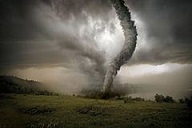Interested in the causes of tornadoes in South Africa? Learn more about South African tornado causes…
The majority of reports that originate from Africa regarding tornadoes refer to events that have occurred in South Africa. There are many causes for the tornadoes in South Africa. Very few reports of tornadoes are available from other regions in the continent but this in no way implies that other regions do not suffer from tornadoes. A hit by a tornadic storm event can become a deadly and devastating event for any region.
Tornadoes in South Africa
There are different causes of South African tornadoes, which are generally created with exceptionally hot air masses accompanied by severe thunderstorms. The majority of the tornadoes occurring in South Africa are actually underreported. An F3 tornado event in 1999 occurred close to the South African metropolis and almost went unreported. The South African Weather Service reports that the majority of the tornadoes have occurred in the Free State, Gauteng, KwaZulu-Natal and the north end of the area formerly known as Transkei.
Buildup of a Tornado
A tornado is a whirling funnel that starts from what appears to be a tube, which starts from a cloud and which eventually touches the ground. The bottom often has translucent dust, which the strong winds pick up and can be accurately described as a violent rotating column of air. Tornadoes are extremely dangerous and powerful storms. The column of whirling air is connected to a cloud on top that is usually a cumulonimbus cloud and rarely may also be the base of an accumulus cloud. These look like condensation funnels. A waterspout tornado, when it occurs in Africa, occurs in tropical regions that are close to the equator. They are not commonly seen at higheraltitudes.
Season for Tornadoes in South Africa
In the main, tornados occur during mid-summer, which is from November to January in the southern hemisphere, where South Africa is. A few tornadoes have also been noticed in summer, which is September and October; while others have sporadically hit different areas during late summer and occasionally in autumn in February till May.
Tornadoes usually occur in the late afternoon or early evening from 4 p.m. to 7 p.m. and 65% of the tornadoes fall into the category of F0 – F1 on the Fujita Scale. These are categorized as light damage tornadoes. Approximately 25% of the tornadoes can be classified as the F2 storms, which cause considerable damage.
There are few tornadoes that have gone above the F3 level. One such event was the Ayliff tornado, which afflicted the Eastern Cape region in 1999 and was classified as an F4 tornado. There have been at least seven killer tornadoes in the last 60 years that hit South Africa and the Ayliff tornado was one of them. It killed 25 individuals and injured more than 500 people. The tornado created havoc along a 25 mile path. After that,, in 1952, Albertynesville, South Africa suffered a devastating tornado that killed 20 citizens and injured 400 residents of that region.





